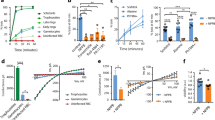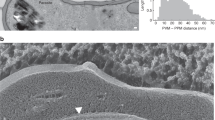Abstract
Malarial parasites propagate asexually inside the erythrocytes of their vertebrate host. Six hours after invasion, the permeability of the host cell membrane to anions and small nonelectrolytes starts to increase and reaches its peak as the parasite matures. This increased permeability differs from the native transport systems of the normal erythrocyte in its solute selectivity pattern, its enthalpy of activation and its susceptibility to inhibitors, suggesting the appearance of new transport pathways. A biophysical analysis of the permeability data indicates that the selectivity barrier discriminates between permeants according to their hydrogen bonding capacity and has solubilization properties compared to those ofiso-butanol. The new permeability pathways could result from structural defects caused in the host cell membrane by the insertion of parasite-derived polypeptides. It is suggested that the unique transport properties of the new pathways be used to target drugs into infected cells, to affect the parasite either directly or through the modulation of the intraerythrocytic environment. The feasibility of drug targeting is demonstrated inin vitro cultures of the human malarial parasitePlasmodium falciparum.
Similar content being viewed by others
References
Allred, D. R., Sterling, C. and Morse, P. (1983).Mol. Biochem. Parasitol. 7:27–39.
Al-Saleh, E. A. and Wheeler, K. P. (1982).Biochim. Biophys. Acta 684:157–171.
Bookchin, R. M., Lew, V. L., Nagel, R. L. and Raventos, C. (1980).J. Physiol. 312:P65.
Bowyer, F. (1957).Int. Rev. Cytol. 6:569–611.
Braun-Breton C., Jendoubi, M., Brunet, E., Perrin, L., Scaife, J., and Da Silva, L. P. (1986).Mol. Biochem. Parasitol. 20:33–43.
Bunang, and Harinasuta, Y. (1986). In:Parasitology—Quo Vadit? (M. Howell, Ed.), Aust. Acad. Sci. Canberra, pp. 169–180.
Cabantchik, Z. I., Kutner, S., Krugliak, M. and Ginsburg, H. (1983).Mol. Pharmacol. 23:92–99.
Collander, R. (1950).Acta Chem. Scand. 4:1085–1098.
Deuticke, B. (1986).Membr. Biochem. 6:309–326.
Deuticke, B., Rickert, I. and Beyer, E. (1978).Biochim. Biophys. Acta 507:137–155.
Divo, A. A., Geary, T. G., Davis, N. L. and Jensen, J. B. (1985).J. Protozool. 32:59–64.
Dunn, M. J. (1969).J. Clin. Invest. 48:674–784.
Elford, B. C., Haynes, J. D., Chulay, J. D. and Wilson, R. J. M. (1985).Mol. Biochem. Parasitol.,16:43–60.
Etkin, N. L. and Eaton, J. W. (1975). In:Erythrocyte Structure and Metabolism (G. J. Brewer, Ed.), A. Liss Inc., New York, pp. 219–232.
Flynn, T. P., Allen, D. W., Johnson, G. J. and White, J. G. (1983).J. Clin. Invest. 71:1215–1223.
Friedman, M. J. (1981). In:Biochemistry and Physiology of Protozoa (M. Lowandovski and S. H. Hunter, Eds.), Academic Press, New York, pp. 463–493.
Ginbsurg, H. and Stein, W. D. (1987).J. Membr. Biol. 96:1–10.
Ginsburg, H., Krugliak, M., Eidelman, O. and Cabantchik, Z. I. (1983).Mol. Biochem. Parasitol. 8:177–190.
Ginsburg, H., Kutner, S., Krugliak, M. and Cabantchik, Z. I. (1985).Mol. Biochem. Parasitol. 14:313–322.
Ginsburg, H., Handeli, S., Friedman, S., Gorodetsky, R. and Krugliak, M. (1986a).Z. Parasitenk. 72:185–199.
Ginsburg, H., Gorodetsky, R., and Krugliak, M. (1986b).Biochim. Biophys. Acta 886:337–344.
Ginsburg, H., Kutner, S., Zangwil, M. and Cabantchik, Z. I. (1986c).Biochim. Biophys. Acta 861:194–196.
Holz, G. G. (1977).Bull. WHO 55:237–248.
Homewood, C. A. and Neame, K. D. (1974).Nature 252:718–719.
Honig, B., Hubbell, W. L. and Flewelling, R. F. (1986).Ann. Rev. Biophys. Biophys. Chem. 15:163–193.
Howard, R. J. (1972).Immunol. Rev 61:67–107.
Howard, R. J. and Sawyer, W. H. (1980).Parasitology 80:331–342.
Knauf, P. (1979).Curr. Top. Membr. Transp. 12:251–363.
Kutner, S., Baruch, D., Ginsburg, H. and Cabantchik, Z. I. (1982).Biochim. Biophys. Acta 687:82–86.
Kutner, S., Ginsburg, H. and Cabantchik, Z. I. (1983).J. Cell. Physiol. 114:245–251.
Kutner, S., Breuer, W. V., Ginsburg, H., Aley, S. B. and Cabantchik, Z. I. (1985).J. Cell. Physiol. 125:521–527.
Kutner, S., Breuer, W. V., Ginsburg, H. and Cabantchik, Z. I. (1986).Biochem. Pharmacol. 36:123–129.
Lambros, C. and Vanderberg, J. P. (1979).J. Parasitol. 65:418–420.
Le Fevre, P. G. (1948).J. Gen. Physiol. 31:505–527.
Lepke, S. and Passow, H. (1973).Biochim. Biophys. Acta 298:529–533.
Lieb, W. R. and Stein, W. D. (1986).J. Membr. Biol. 92:111–119.
Neame, K. D. and Homewood, C. A. (1975).Int. J. Parasitol. 5:537–540.
Pfaller, M. A., Krogstadt, D. J., Parquette, A. R. and Nguyen-Dinh, P. (1982).Exp. Parasitol. 54:391–396.
Renkin, E. M. (1954).J. Gen. Physiol. 38:225–243.
Rieckmann, K. H. (1983).Ann. Rev. Med. 34:321–325.
Roth, E. F., Schulman, S., Vanderberg, J., and Olson, J., (1986).Blood 67:827–830.
Scheibel, L. W. and Adler, A. (1982).Mol. Pharmacol. 22:140–144.
Seed, T. and Kreier, J. (1972).Proc. Helminth. Soc. Wash. 39:387–411.
Sherman, I. W. (1979).Microbiol. Rev. 43:453–495.
Sherman, I. W. (1985).Parasitology 91:609–645.
Sherman, I. W. and Tanigoshi, L. (1974a).J. Protozool. 21:603–607.
Sherman, I. W. and Tanigoshi, L. (1974b).Exp. Parasitol. 35:369–373.
Sherman, I. W. and Greenan, L. (1984).Trans. Roy. Soc. Trop. Med. Hyg. 78:641–644.
Stein, W. D. (1967).The Movement of Molecules Across Cell Membranes. Academic Press, New York.
Van Hoogevest, P., Du Maine, A. P. M., De Kruijff, B., and De Gier, B. (1984).Biochim. Biophys. Acta 777:241–252.
Vial, H. J., Thuet, M. J. and Philippot, J. R., (1982).J. Protozool. 29:258–263.
Yeagle, P. L. (1985).Biochim. Biophys. Acta 822:267–287.
Zarchin, S., Krugliak, M. and Ginsburg, H. (1986).Biochem. Pharmacol. 35:2435–2442.
Author information
Authors and Affiliations
Rights and permissions
About this article
Cite this article
Ginsburg, H., Stein, W.D. New permeability pathways induced by the malarial parasite in the membrane of its host erythrocyte: Potential routes for targeting of drugs into infected cells. Biosci Rep 7, 455–463 (1987). https://doi.org/10.1007/BF01116501
Received:
Issue Date:
DOI: https://doi.org/10.1007/BF01116501




